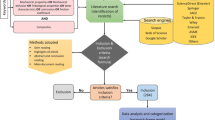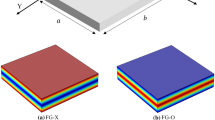Abstract
The use of composite materials has increased lately and the need to know the behavior of these materials is very important once these devices are subject to suffer from damage such as cracks and delamination. Normally, to analyze failure problems in composite materials, the following steps are necessary: (1) structure geometry design, (2) numerical and/or experimental analysis and (3) use of failure criteria (e.g., Tsai–Wu failure criterion). If the used composite material has a non-expected failure criterion, the procedure must be repeated. In order to eliminate the procedure above, this study proposes the use of an artificial neural networks (ANN) inversion which can be used to determine an adequate configuration for the layers of the composite material from the desired failure criteria value. Numerical simulations, based on the finite element method, were made in order to create a database for ANN training and validation. After the inversion of the ANN, satisfactory results were obtained and this procedure could be used to minimize the high number of numerical simulations normally used in the design of a composite device.





Similar content being viewed by others
References
C.A.R. Brito Jr., E.M. Bezerra, L.C. Pardini, A.C. Ancelotti Jr., M.S. Pereira, E. De Barros, L.R. De Carmargo, Redes neurais artificiais aplicadas para a predição do comportamento dinâmico-mecânico de compósitos de matriz epóxi reforçados com fibras de carbono. Mag. Mater. 12(2), 346–357 (2007)
F.C. Campbell, Structural Composite Materials (ASM International, Novelty, 2010)
E.K.P. Chong, S.H. Zak, An Introduction to Optimization (Wiley, Hoboken, 2001)
D.I.G. Costa, Análise numérica de falhas em materiais compósitos laminados usando um critério baseado em fenômenos físicos, Dissertations (Master in Engineering), State University of Campinas, Campinas, 2011
I.M. Daniel, O. Ishai, Engineering Mechanics of Composite Materials (Oxford University Press, New York, 1994)
H. Debski, J. Jonak, Failure analysis of thin-walled composite channel section columms. Compos. Struct. 132, 567–574 (2015)
A. Fenza, A. Sorrentino, P. Vitiello, Application of artificial neural networks and probability ellipse methods for damage detection using Lamb waves. Compos. Struct. 133, 390–403 (2015)
G.F. Gomes, C.A. Diniz, S.S. Cunha, A.C. Ancelotti, Design optimization of composite prosthetic tubes using GA-ANN algorithm considering Tsai–Wu failure criteria. J. Fail. Anal. Prev. 17(4), 740–749 (2017)
S. Haykin, Neural Networks and Learning Machines (Pearson, Hoboken, 2009)
A.K. Kaw, Mechanics of Composite Materials (CRC Press, Boca Raton, 2006)
M. Koc, F.O. Sonmez, N. Ersoy, K. Cinar, Failure behavior of composite laminates under four-point bending. J. Compos. Mater. 50(2), 1–19 (2016)
A.J. Kolios, S. Proia, Evaluation of the reliability performance of failure criteria for composite structures. World J. Mech. 2, 162–170 (2012)
Z.L. Kovács, Redes Neurais Artificiais: Fundamentos e Applicações (Academic, Sao Paulo, 1996)
U.K. Mallela, A. Upadhyay, Buckling load prediction of laminated composite stiffened panels subjected to in-plane shear using artificial neural networks. Thin Walled Struct. 102, 158–164 (2016)
A.T.D. Martins, Projeto e fabricação de tubos compósitos em fibras de carbono/epóxi pata próteses transtibiais por moldagem com bladder, Dissertations (Master in Engineering), Federal University of Itajubá, Itajubá, 2015
D.C. Montgomery, E.A. Peck, G.G. Vining, Introduction to Linear Regression Analysis (Wiley, Hoboken, 2012)
P. Selva, O. Cherrier, V. Budinger, F. Lachaud, J. Morlier, Smart monitoring of aeronautical composites plates based on electromechanical impedance measurements and artificial neural networks. Eng. Struct. 56, 794–804 (2013)
C. Velmurugan, V. Muthukumakan, K. Ragupathy, S. Ragunath, Modeling volume loss of heat treated AL 6061 composites using an artificial neural networks. Proc. Mater. Sci. 5, 31–40 (2014)
G.Z. Voyiadjis, P.I. Kattan, Mechanics of Composite Materials with Matlab (Springer, Berlin, 2005)
B. Yegnanarayana, Artificial Neural Networks (Prentice-Hall of India Private Limited, New Delhi, 2005)
Acknowledgments
The authors would like to acknowledge the financial support from the Brazilian agency CAPES – Coordenação de Aperfeiçoamento de Pessoal de Nível Superior.
Author information
Authors and Affiliations
Corresponding author
Additional information
Publisher's Note
Springer Nature remains neutral with regard to jurisdictional claims in published maps and institutional affiliations.
Appendix
Appendix
In order to verify the correlation between the data used in the ANN training and validation, a linear regression analysis was proposed. In this study were considered independent variables that are known orientations and the dependent variables that are the orientation generated by the network. The fit is measured by coefficient of determination (R2), that has its values \(0 \le R^{2} \le 1\), nearer on one the coefficient demonstrates that the variables clarify the regression model [16].
Regression analysis was made for the neural network with three layers and an input, three layers and two inputs and six layers and one input (Fig. 6).
Rights and permissions
About this article
Cite this article
Diniz, C.A., Cunha, S.S., Gomes, G.F. et al. Optimization of the Layers of Composite Materials from Neural Networks with Tsai–Wu Failure Criterion. J Fail. Anal. and Preven. 19, 709–715 (2019). https://doi.org/10.1007/s11668-019-00650-w
Received:
Published:
Issue Date:
DOI: https://doi.org/10.1007/s11668-019-00650-w





